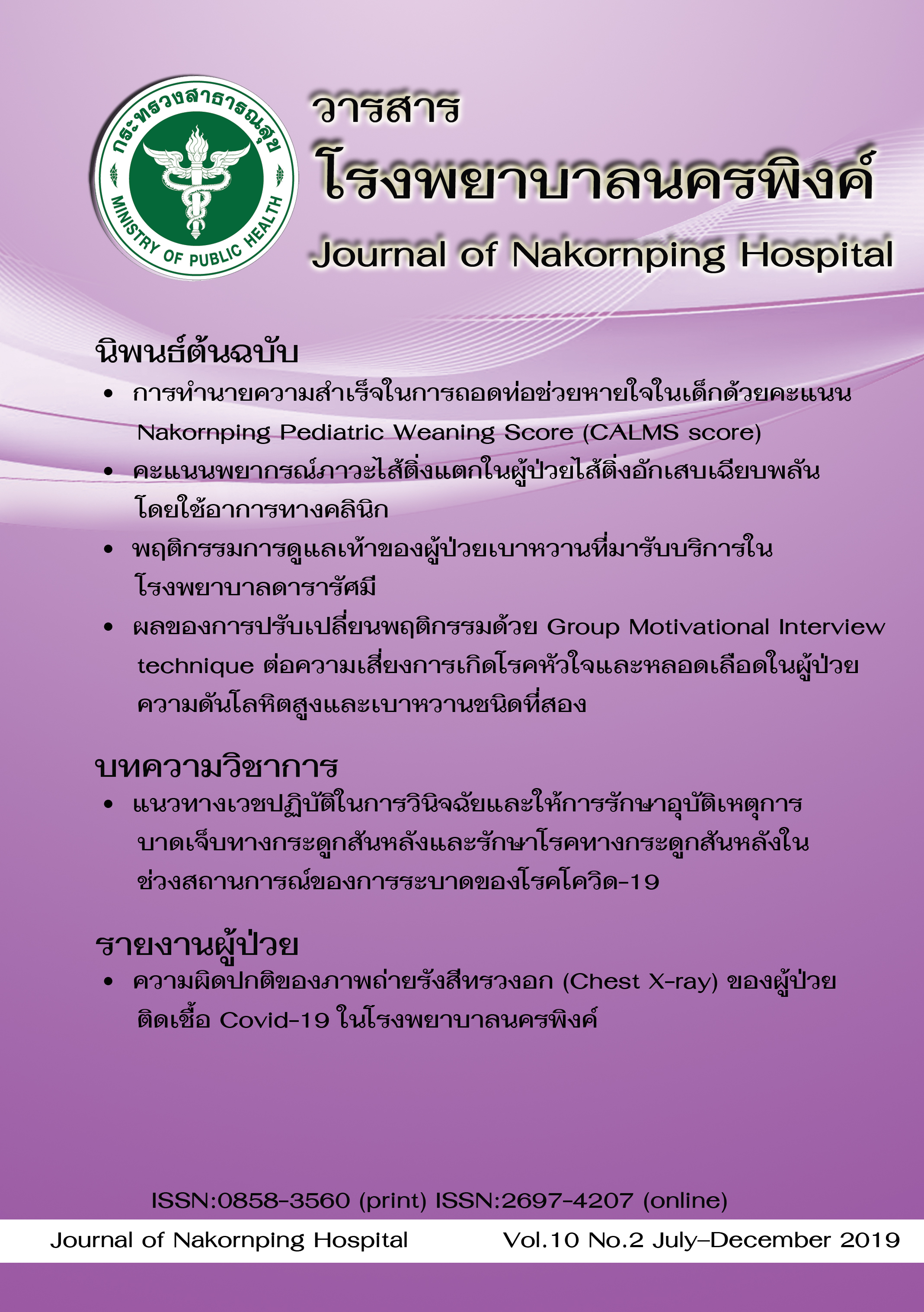คะแนนพยากรณ์ภาวะไส้ติ่งแตกในผู้ป่วยไส้ติ่งอักเสบเฉียบพลันโดยใช้อาการทางคลินิก
คำสำคัญ:
ระบบคะแนน, ปัจจัยเสี่ยง, ไส้ติ่งแตก, ไส้ติ่งอักเสบบทคัดย่อ
วัตถุประสงค์ : สร้างระบบคะแนนใช้พยากรณ์ภาวะไส้ติ่งแตกในผู้ป่วยไส้ติ่งอักเสบเฉียบพลันโดยใช้อาการทางคลินิก
วิธีดำเนินการวิจัย : การศึกษานี้เป็นงานวิจัยเชิงพยากรณ์การวินิจฉัย(Diagnostic Prediction Research) โดยใช้ข้อมูลผู้ป่วยไส้ติ่งอักเสบอายุ >15 ปี ได้ผ่าตัด และมีผลพยาธิวิทยาของไส้ติ่ง เข้ารับการรักษาในโรงพยาบาลนครพิงค์ ระหว่างวันที่ 1 มกราคม ถึง 31 ธันวาคม 2561 เก็บรวบรวมข้อมูลเปรียบเทียบปัจจัยเสี่ยงแล้วนำมาวิเคราะห์สร้างเป็นระบบคะแนนใช้พยากรณ์ภาวะไส้ติ่งแตกในผู้ป่วยไส้ติ่งอักเสบเฉียบพลัน
ผลการวิจัย : ผู้ป่วยรับการผ่าตัด และมีผลพยาธิวิทยาทั้งหมดมี 499 คน นำมาวิเคราะห์เพื่อพยากรณ์ภาวะไส้ติ่งแตก พบปัจจัยเสี่ยง 5 ปัจจัยที่มีความสำคัญทางคลินิก ได้แก่ เพศชาย(adjusted OR=8.42, P<0.001), อายุระหว่าง >20-60 ปี(adjusted OR=2.56, P=0.005) และอายุ >60 ปี(adjusted OR=3.67, P=0.001), ระยะเวลาตั้งแต่ปวดท้องจนถึงโรงพยาบาล >24 ชั่วโมง(adjusted OR=1.96, P=0.005), อัตราการเต้นของหัวใจ >=130 ครั้งต่อนาที(adjusted OR=8.58, P=0.005) และการตรวจท้องพบ localized rebound tenderness บริเวณขวาล่าง(adjusted OR=1.51, P=0.092) ทำเป็นระบบคะแนน มีคะแนนรวม 0-16 คะแนน นำมาแบ่งความเสี่ยงในการพยากรณ์การแตกของไส้ติ่งแบ่งได้ 3 กลุ่ม คือกลุ่มเสี่ยงมาก(คะแนน >= 11) มีโอกาสเกิดไส้ติ่งแตกสูง(LR+=12.15, P<0.001), กลุ่มเสี่ยงปานกลาง(คะแนน 6-10) มีโอกาสเกิดไส้ติ่งแตกปานกลาง(LR+=1.70, P<0.001) และกลุ่มเสี่ยงน้อย(คะแนน <= 5) มีโอกาสไส้ติ่งแตกต่ำ(LR+=0.22, P<0.001) ระบบคะแนนพยากรณ์ภาวะไส้ติ่งแตกในผู้ป่วยไส้ติ่งอักเสบเฉียบพลันนี้มีประสิทธิภาพในการพยากรณ์ได้เท่ากับ 77.98%(area under the ROC, (95% CI=1.38-1.67))
สรุปผลงานวิจัย : ระบบคะแนนนี้อาจนำมาใช้พยากรณ์ภาวะไส้ติ่งแตกในผู้ป่วยไส้ติ่งอักเสบเฉียบพลันได้ สามารถนำไปใช้ได้ทั้งโรงพยาบาลระดับชุมชน และระดับจังหวัด เพื่อเป็นแนวทางในการตัดสินใจในการส่งตัวผู้ป่วยมารักษาต่อ, ตัดสินในการรักษา และการให้ข้อมูลคำแนะนำแก่ผู้ป่วยและญาติได้
เอกสารอ้างอิง
Ferris M, Quan S, Kaplan BS, Molodecky N, Ball CG, Chernoff GW, et al. The Global Incidence of Appendicitis: A Systematic Review of Population-based Studies. Ann Surg. 2017 Aug;266(2):237-241.
Brunicardi FC, Andersen KD, Billiar TR, Dunn LD, Hunter GJ, Matthews BF, et al. Schwartz’s principles of surgery. 10th edition. OH, United States. McGraw-Hill Education. 2015.
Kalan M, Talbot D, Cunliffe WJ, Rich AJ. Evaluation of the modified Alvarado score in the diagnosis of acute appendicitis: a prospective study. Ann R Coll Surg Engl.1994;76(6):418-9.
Shuaib A, Shuaib A, Fakhra Z, Marafi B, Alsharaf K, Behbehani A. Evaluation of modified Alvarado scoring system and RIPASA scoring system as diagnostic tools of acute appendicitis. World J Emerg Med. 2017;8(4):276-80.
Bickell NA, Aufses AH, Jr., Rojas M, Bodian C. How Time Affects the Risk of Rupture in Appendicitis. J Am Coll Surg. 2006;202(3):401-6.
MMR Eddama, KC Fragkos, S Renshaw. Logistic regression model to predict acute uncomplicated and complicated appendicitis. Ann R Coll Surg Engl 2018; 00: 1–12
World HPiT. Statistics of appendicitis, Thai people killed in the hospital. Hfocus. 2561.
Sirikurnpiboon S, Amornpornchareon S. Factors Associated with Perforated Appendicitis in Elderly Patients in a Tertiary Care Hospital. Surg Res Pract. 2015;2015: 681-847.
Paidipelly KK, Sangamitra. Risk factors of acute and perforated appendicitis in a semi-rural population: a retrospective study. Int Surg J 2018; 5 (7) : 2432-2436. DO - 1018203/2349-2902isj20182488. 2018.
Ahmad T, Ali Z, Ali A, Anjum S. Perforated appendix: Contributing factors. JUMDC. 2010 1(2):11-6.
SCOAP Collaborative, Cuschieri J, Florence M, Flum DR, Jurkovich GJ, Lin P, et al. Negative appendectomy and imaging accuracy in the Washington State Surgical Care and Outcomes Assessment Program. Ann Surg 2008; 248(4): 557–563.
Stein GY, Rath-Wolfson L, Zeidman A, Atar E, Marcus O, Joubran S, et al. Sex differences in the epidemiology, seasonal variation, and trends in the management of patients with acute appendicitis. Langenbecks Arch Surg. 2012 Oct;397(7):1087-92.
Atiksawedparit P, SittichanbunchaPongsakorn Y, Factor associated with non-perforated appendicitis and perforated appendicitis at ER Ramathibodi hospital. Thammasat Medical Journal. 2013;13(1):36-42.
Sheu BF, Chiu TF, Chen JC, Tung MS, Chang MW, Young YR. Risk factors associated with perforated appendicitis in elderly patients presenting with signs and symptoms of acute appendicitis. ANZ J Surg. 2007 Aug;77(8):662-6.
Omari AH, Khammash RM, Qasaimeh RG, Shammari KA, Bani Yaseen KM, Hammori KS. Acute appendicitis in the elderly: risk factors for perforation. World J Emerg Surg. 2014; 9: 6.
Horattas M, Guyton D, Diane W. A reappraisal of appendicitis in theelderly. Am J Surg. 1990; 160:291–293.
Smithy WB, Wexner SD, Daily TH. The diagnosis and treatment of acute appendicitis in the aged. Dis Colon Rectum. 1986; 29:170–173.
Franz MG, Norman J, Fabri PJ. Increased morbidity of appendicitis with advancing age. Am Surg. 1995; 61:40–44.
Storm-Dickerson TL, Horattas MC. What we have learned over the past 20 years about appendicitis in the elderly? Am J Surg. 2003; 185:198–201.
Lunca S, Bouras G, Romedea NS. Acute appendicitis in the elderly patient: diagnostic problems, prognostic factors and out-comes. Rom J Gastroenterol. 2004; 13:299–303.
Lee JF, Leow CK, Lau WY: Appendicitis in the elderly. ANZ J Surg. 2000; 70:593–596.
Sherlock DJ: Acute appendicitis in the over-sixty age group. Br J Surg. 1985; 72:245–246.
Lau WY, Fan ST, Yiu TF, Chu KW, Lee JM: Acute appendicitis in the elderly. Surg Gynecol Obstet. 1985 ;161(2):157-60.
Tantarattanapong S, Arwae N. Risk factors associated with perforated acute appendicitis in geriatric emergency patients. Open Access Emerg Med. 2018 Oct 4;10:129-134.
Temple CL, Huchcroft SA, Temple WJ. The natural history of appendicitis in adults: a prospective study. Ann Surg. 1995; 221(3): 278–281.
Marcelo A. Beltrán. The Systemic Inflammatory Response in Patients with Appendicitis: a Progressive Phenomenon. Indian J Surg. December 2015;77(Suppl 3): S1050–S1056.
Seamus P W,Venkata N, Michael J B et al. Association between resting heart rate and inflammatory biomarkers. Am J Cardiol. 2014 February 15; 113(4): 644-649.
Yashwant R L, Varsha P G. The role of rebound tenderness in acute appendicitis and appendicular perforation. Int Surg J. 2017 Feb;4(2):725-727.
Ghag GS, Shukla SK, Shukla DB, Bhalerao DU. A comparative study of perforated and non-perforated appendicitis with respect to clinical findings, radiological findings and post-operative management. Asian Pac. J. Health Sci. 2016; 3(4S):5-13.
ดาวน์โหลด
เผยแพร่แล้ว
รูปแบบการอ้างอิง
ฉบับ
ประเภทบทความ
สัญญาอนุญาต
บทความที่ได้รับการตีพิมพ์เป็นลิขสิทธิ์ของโรงพยาบาลนครพิงค์ จ.เชียงใหม่
ข้อความที่ปรากฏในบทความแต่ละเรื่องบทความในวารสารวิชาการและวิจัยเล่มนี้เป็นความคิดเห็นส่วนตัวของผู้เขียนแต่ละท่านไม่เกี่ยวข้องกับโรงพยาบาลนครพิงค์ และบุคลากรท่านอื่นๆในโรงพยาบาลฯ ความรับผิดชอบเกี่ยวกับบทความแต่ละเรื่องผู้เขียนจะรับผิดชอบของตนเองแต่ละท่าน



